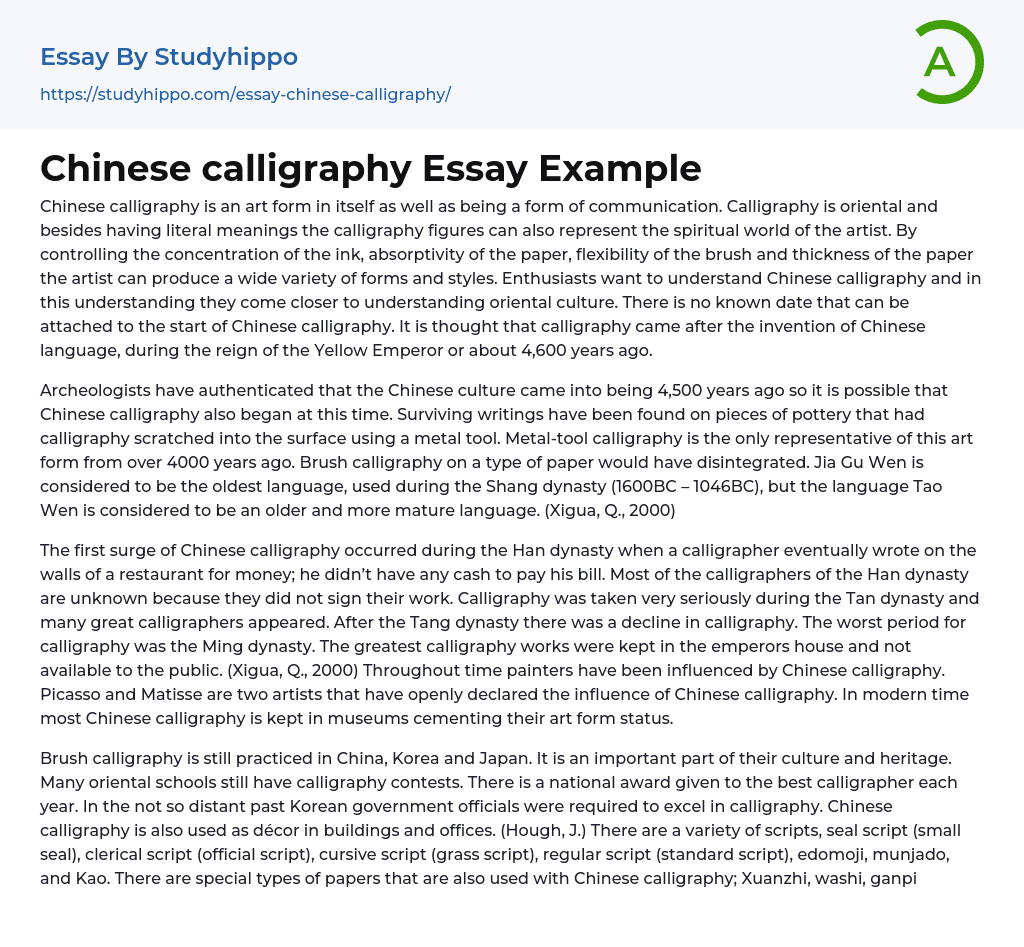Chinese calligraphy is an art form in itself as well as being a form of communication. Calligraphy is oriental and besides having literal meanings the calligraphy figures can also represent the spiritual world of the artist. By controlling the concentration of the ink, absorptivity of the paper, flexibility of the brush and thickness of the paper the artist can produce a wide variety of forms and styles. Enthusiasts want to understand Chinese calligraphy and in this understanding they come closer to understanding oriental culture. There is no known date that can be attached to the start of Chinese calligraphy. It is thought that calligraphy came after the invention of Chinese language, during the reign of the Yellow Emperor or about 4,600 years ago.
Archeologists have authenticated that the C
...hinese culture came into being 4,500 years ago so it is possible that Chinese calligraphy also began at this time. Surviving writings have been found on pieces of pottery that had calligraphy scratched into the surface using a metal tool. Metal-tool calligraphy is the only representative of this art form from over 4000 years ago. Brush calligraphy on a type of paper would have disintegrated. Jia Gu Wen is considered to be the oldest language, used during the Shang dynasty (1600BC – 1046BC), but the language Tao Wen is considered to be an older and more mature language. (Xigua, Q., 2000)
The first surge of Chinese calligraphy occurred during the Han dynasty when a calligrapher eventually wrote on the walls of a restaurant for money; he didn’t have any cash to pay his bill. Most of the calligraphers of the Han dynasty ar
unknown because they did not sign their work. Calligraphy was taken very seriously during the Tan dynasty and many great calligraphers appeared. After the Tang dynasty there was a decline in calligraphy. The worst period for calligraphy was the Ming dynasty. The greatest calligraphy works were kept in the emperors house and not available to the public. (Xigua, Q., 2000) Throughout time painters have been influenced by Chinese calligraphy. Picasso and Matisse are two artists that have openly declared the influence of Chinese calligraphy. In modern time most Chinese calligraphy is kept in museums cementing their art form status.
Brush calligraphy is still practiced in China, Korea and Japan. It is an important part of their culture and heritage. Many oriental schools still have calligraphy contests. There is a national award given to the best calligrapher each year. In the not so distant past Korean government officials were required to excel in calligraphy. Chinese calligraphy is also used as décor in buildings and offices. (Hough, J.) There are a variety of scripts, seal script (small seal), clerical script (official script), cursive script (grass script), regular script (standard script), edomoji, munjado, and Kao. There are special types of papers that are also used with Chinese calligraphy; Xuanzhi, washi, ganpi, and mitsumata. These papers are made from rice, bamboo, hemp, paper mulberry, and wheat.
The ink is made from lampblack and binders. It comes in sticks and rubbed with water on an ink stone until the desired consistency is made. (Hough, J.) While Chinese calligraphy is an extremely old art form it is still practiced today in the west. It is considered an art form
throughout the world and displayed in many museums. It is a rare occurrence that an art form has lasted over 4,000 years. While the language has changed and new styles evolved the original spirit of Chinese calligraphy has not changed. It is still an expression of the artist as well as a form of communication.
References:
Hough, J., History of Chinese Calligraphy, http://www.art-virtue.com/history/index.htm, accessed May 2, 2008 Xīguī, Q., Chinese Writing, Early China Special Monograph Series No. 4. Berkeley: The Society for the Study of Early China and the Institute of East Asian Studies, University of California, Berkeley, 2000
- Design essays
- Graffiti essays
- Graphic essays
- Typography essays
- Painting essays
- Photography essays
- Sculpture essays
- Architecture essays
- Interior design essays
- Arch essays
- Area essays
- Bangladesh essays
- China essays
- Hong Kong essays
- India essays
- Japan essays
- Kuala Lumpur essays
- Malaysia essays
- Manila essays
- Pakistan essays
- Philippines essays
- Singapore essays
- Vietnam essays
- Vietnamese essays
- African American essays
- African American Culture essays
- American Values essays
- Asian American essays
- Chinese essays
- Ethnicity essays
- Ethnocentrism essays
- German essays
- Han Chinese essays
- Hispanic essays
- Identity essays
- Korean essays
- Mexican essays
- Nation essays
- Native American essays
- Race and Ethnicity essays
- White People essays
- Aesthetics essays
- Art History essays
- Artist essays
- ballet essays
- Body Art essays
- Color essays
- Concert Review essays
- Creativity essays
- Cultural Anthropology essays




